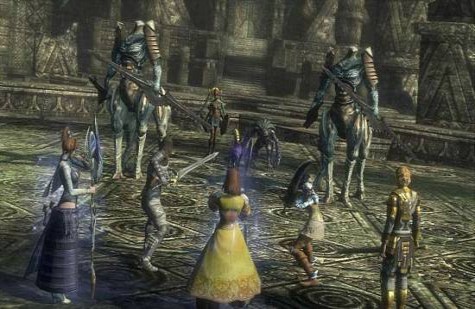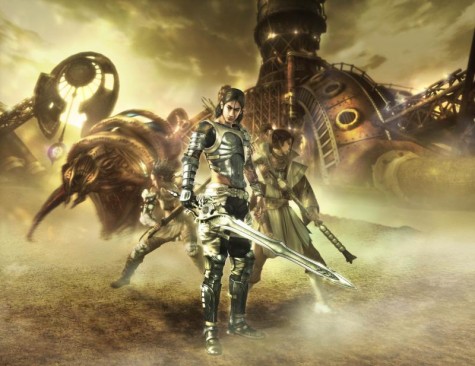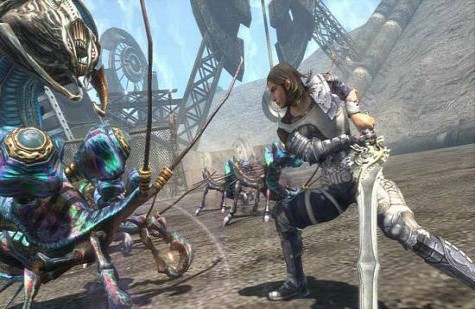Latest Gear Live Videos
Monday February 11, 2008 6:24 pm
Lost Odyssey Review

Posted by Andru Edwards Categories: Adventure, Features, Microsoft, Reviews, Role Playing Games, Square Enix, Xbox 360,

It is no secret to anyone who knows me that I have a deep appreciation for games in quirky, niche, genres, and also intelligent stories. Frankly, it is rare that I get to find both of these needs met in a single game, but Lost Odyssey manages to do it.
But wait! I thought Lost Odyssey was a Japanese-RPG and thus not really niche? Sadly (in my opinion), the gaming landscape has changed so profoundly over the years that the once thriving JRPG is now increasingly a rarity; One with high-production values, so much the more. Several early reviews would have you believe that Lost Odyssey does something fundamentally wrong simply for being true to its genre. Mercifully, you are reading this review so at the very least let me try to paint a slightly different picture of Hironobu Sakaguchi’s latest opus.
Lost Odyssey, for all intents and purposes, is the Final Fantasy of a contemporary generation that we would have seen from Sakaguchi and crew had he stayed in the employ of legendary developer Square-Enix. Sadly, in the aftermath of a film failure helmed by the genius designer, he parted ways with the company he helped find a place in gaming history. Mist-Walker, formed by Sakaguchi with several long term collaborators, was born there-after with the (at the time) controversial goal of bringing several major RPGs exclusively to the Xbox 360. Where their first title, Blue Dragon, proved a fun, if excessively joyful endeavor, Lost Odyssey was to be their deadly serious attempt at bringing adult themes to a world dominated by e feet male leads who seemingly always come into adult-hood while saving the world.

SO WHAT’S IT ABOUT?
To this narrative end, arguably the most significant element to a role-playing game, Lost Odyssey fantastically delivers. What you will experience across the span of some forty-hours of CORE game play (plenty of side-quests exist), is the story of Kaim, an immortal not entirely unlike those of Highlander fame. As one might imagine, a thousand years of love and loss set a profound foundation upon which to build a story, but when we first meet Kaim he is able to function simply because he cannot remember any of it. What extends outwards from this idea is a plot that is as much, if not more so, character driven, than it is plot driven. This is where our game becomes divisive. Yes, there is world-saving to be done, but the pathos you are meant to feel for our largely immortal cast works because it is rooted in small, intimate stories. You’re awed by the beasts Kaim, Seth, and crew fell… but you are moved because of their heart-ache and personal ability to discover who they are, and who they need to become.
The story is not without fault mind you. There are strange choices the writers have made which most egregiously call upon some of the typical adventure tropes. It is difficult to be entirely without spoiler content, but needless to say, you will have figured out who the “four heroes of legend” are, well before the game flat out says it to the slower crowd. This really appears time and again when discussing the broad plot of the game. The bottom line is this… when the game is focused on a character (their stories are frequently told through the text based “Thousand Year Dreams”) it is absolutely masterful. When we return to the macro plot of world-saving, we quickly find ourselves in a “merely solid” and somewhat conventional place.
One more item of note as it pertains to the “Thousand Year Dreams”. During the span of the game, you will be reading a novella’s worth of these textual back-stories. Each are fantastic, but have seemingly attained the power to scare away the impatient. Now, the designer in me appreciates that this is not the best use of our format’s strengths, but one could easily argue that the stark difference of these stories when told against the more conventional means exists for effect. These are quiet, introspective moments for key characters, and we are almost providing them the respect they deserve when in a somber moment we reminisce with them. Skip these if you must, but realize you are doing a disservice to the game in doing so.

BUT HOW DOES IT PLAY?
Having spent this amount of space talking about narrative you might expect I would have pages upon pages to say about Lost Odyssey’s gameplay. Almost shockingly, this is not the case. Lost Odyssey is precisely what you expect it to be if you have played Square-Enix or similar RPGs for the past decades. I would never hold this against the game, and its adherence to convention should not scare you away either. That said, while no points can be taken from the game due to its traditional turn-based combat (which is not particularly frequent by genre standards), it cannot be praised for any note-worthy innovations. The fundamental nature of turn-based gameplay may not need to change for fans (myself included) but a certain amount of depth can be added to combat systems.
The ability to fight, cast a spell, use an item, or flee, are mainstays of the JRPG, and they are all you are getting in Lost Odyssey. For good or ill (depending again, on your tastes), this title proves to be a particularly pure love-letter to the JRPG with no frills outside of a ring-system, which in function is similar to those found in ShadowHearts (unsurprisingly created by many of the same developers). Players can hold down a trigger and release in time to a ring which shrinks in size, to eventually over-lap with a second one. Doing so creates a more perfectly executed attack or spell, a mechanic seen (even if not visually in the same way), in everything from the aforementioned ShadowHearts to Paper-Mario.
Players will find a very traditional level-up system in place, even if its outward appearance is a reversal of what you might be familiar with. Each level is always seperated by one-hundred experience points (earned in combat), versus a more customary gap that increases at each further level. Enemies in a given area will give less experience as your level rises, meaning at some point, the game is all but insisting that you move on for greater rewards. However, old-school grinders can rest easy knowing enemies always reward you, even if it is a piddling one-exp, so you can out-pace enemy levels if you so choose. Oh… and enemies do NOT grow stronger to arbitrarily match your level, so feel free to squash those enemies who once caused you so much grief.
Rings extend in function beyond this visual representation of combat timing into the game’s accessory system. “Armor” finds itself essentially replaced with the ability to equip customized rings. Ring creation is limited to something not entirely foreign to Western MMORPG players. You’ll frequently collect materials which can make these rings (from combat or otherwise), and can in turn combine the abilities on rings to occasionally produce stronger versions or wildly different rings. Rings can be swapped in combat which actually leads to a fair bit of the game’s strategic boss encounters, depth. Many bosses will kindly telegraph elemental, or status ailment baring attacks giving you time to change your ring and mitigate the results of a beastly bit of offense.
Oh, and for our astute players…. Yes… the “ring” is symbolic and is woven throughout the plot and the mechanics, a tactic employed by only the finest game makers in the world.
SO YOU’RE SAYING IT HAS PERSONALITY. UH OH!
Technically the game succeeds in most regards, though the Unreal Engine once again proves frustrating when it comes time to produce a solid frame-rate. This is no action title however so frame-rate issues prove to create the stray ugly moment with no real gameplay repercussions. Luckily the game’s incredible art direction and strong stylistic approach to enemy designs and sort forth quickly overwhelm any minor hitches and get right to the business of stirring the soul. The steam-punk world of Lost Odyssey leaves behind the day-glo colours of a more exuberant RPG like Blue Dragon, opting instead to give a darker, grittier palate to players. The world “pops” as a result having this almost surreal blend of realism and anime-influenced looks. The game has been accused of having “dull” characters which I think stems from the creator’s ability to avoid the “fifty-belts” design of recent memory.
Much has been said about Lost Odyssey’s fairly common loading screens. The game certainly does load often, though not for exceptionally long periods. A typical battle (of which you might fight two of in a fairly large room) will have about five seconds of loading upon entry, with new rooms loading in about twenty seconds. Rather than cast a judgment on this, I simply report these facts and leave it to your own personal patience level. For what it is worth, I never felt so drastically removed from the experience that load-times genuinely upset me.
Finally, no attempt to discuss an RPG can take place without a mention of the soundtrack. Here Uematsu provides a masterful score that can be haunting, tragic, and even joyous in turn, within one song. This layered music well suits characters with a more-than average set of motivations and qualities, even if it does periodically tease older players with nods to songs past. A “Mysidia” like theme, mere notes away from that which appeared in Final Fantasy 4, even accompanying characters Cook and Mack, who had might as well be called Palom and Porom.. This “familiarity” extends throughout the soundtrack, rarely feeling cheap, and instead serving as a wink to players who have followed this dream-team of RPG makers through the years. Also worth noting is that while no track emerges as a memorable theme (ala the Final Fantasy Crystal theme), there are no disastrous tracks such as the boss-battle music in Mist-Walker’s last outing.

SO SHOULD I BUY IT OR NOT?
As my comments on the music implied, Lost Odyssey very much feels like a loving send-off, or perhaps a call for the reemergence of, the conventional JRPG. Its typicality can only offend those who have no enjoyed the genre previously. While it does little to attract new fans, however, Lost Odyssey brilliantly captures everything the older RPG fan wants in their game. Memorably characters (including one of the most fun lecherous types in recent memory), a rousing score, and technology which takes the epic journeys of our imagine, and transplants it into something we can experience (gone are sprite characters TALKING about what they see in a far off vista…. its is all there for us to behold), all result in a game that purists will find captivating. Die-hards will frequently suggest that RPG’s veered off course at some point and became something wildly different than the children of the 16bit era recall. Leaving the world of Lost Odyssey, I can’t help but feel this game is what we would have seen more of had they they taken that other path at the fork.
9.2/10
- Related Tags:
- adslice, hironobu sakaguchi, lost odyssey, lost odyssey review, reviews, role playing games, rpg, sidefeatured, square-enix, xbox 360
Advertisement
Advertisement
Advertisement
© Gear Live Media, LLC. 2007 – User-posted content, unless source is quoted, is licensed under a Creative Commons Public Domain License. Gear Live graphics, logos, designs, page headers, button icons, videos, articles, blogs, forums, scripts and other service names are the trademarks of Gear Live Inc.











Comments:
have not play this play game yet but from the sound of it, its look good.i have play quite a lot of square enix or squaresoft title and never once they have fail to leave me in awe. right now i m still waiting for the release of final fantasy 13 and i have high hope for it..
I’ve been dying to get my hands on this. Not sure about the whole inconsistant graphics thing from what i’ve seen the game looks great. I’ll just have to get a copy and see for myself I guess.